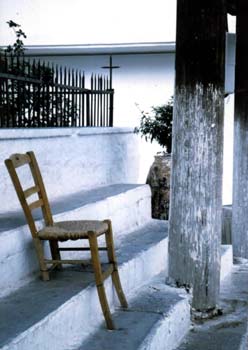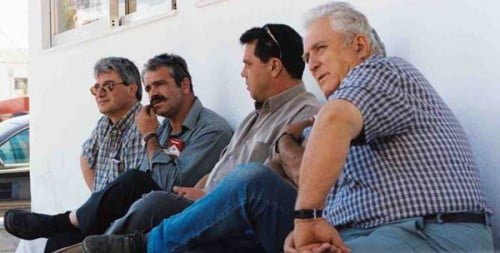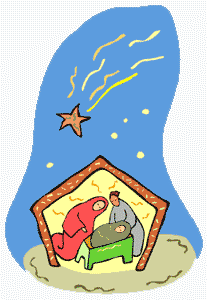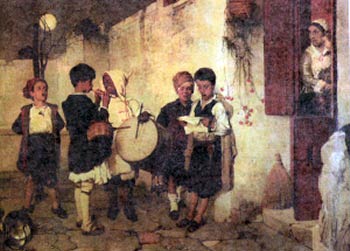Alonia, The Threshing Circles Of Crete
When I put out my appeal for more information about Cretan alonia, or threshing circles, I wasn’t expecting to write the kind of article that follows. I wasn’t expecting Yannis to offer to take me to a village in the mountains called Ano Asites to visit a man like Manolis Piperakis who has helped to open a village museum, restored his local alonia, and even started a tradition of demonstrating their use to tourists every summer. Life in Crete as ever is full of surprises.
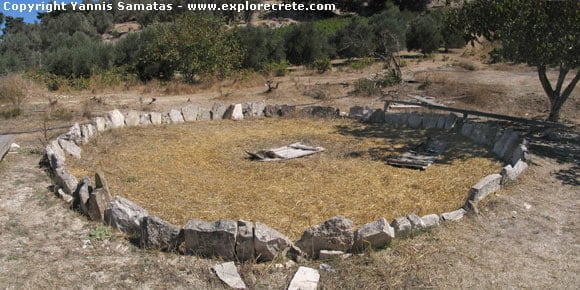
The area of the village south west of Heraklion was new territory for me, and the village itself a delightful one. Traditional without being in the least run down, it was a riot of colourful flowers even at the end of September, and beautifully kept throughout. We met a party of foreign visitors being shown round the byzantine church of Agios Antonios with a sacred cave and well behind it. They were being offered a picnic of raki , cheese and fruit, which we were invited to share. This is the kind of visitor that are being attracted to the area of Asites, and being encouraged to take an active and respectful interest in the culture. The environment is benefiting by being maintained and enhanced. How different from the areas that are being destroyed by tourist and foreign housing development, like Apokoronas. There are as yet no foreigners building houses in the village of Asites, and that is apparently how the locals would like to keep it.
Manolis had taken an afternoon off his work at a building restoration to talk to us. After showing us the two alonia he had protected nearby, we went to his traditional home in the village, which itself had some of the feeling a folk museum, especially the cellar with it’s vast wine barrels, and beautifully preserved old tools, hand-woven baskets and farm equipment.
I had a list of questions, but first, Manolis offered to explain the process of using the threshing circles as he remembered it. He said the circles had been used for threshing up until the 1980s, which was a couple of decades later than I had imagined.
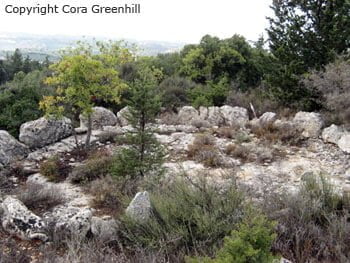 Aloni with stone floor in west Crete |
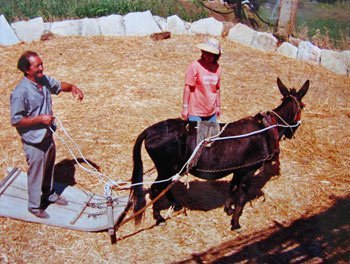 Old photo with Manolis Piperakis threshing in his aloni |
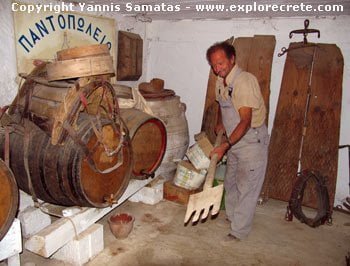 Manolis showing to us how they used to separate the wheat from the chaff |
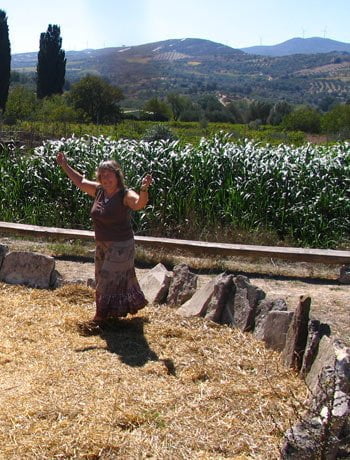 Cora performing her own dance inside an aloni |
The first major task was making the floor of the aloni smooth enough for the grain to be threshed and collected as a clean product. This meant remaking the floor each year before the harvest, using mud and straw beaten down and smoothed, along similar principles to making mud bricks.
Making the floor of the circle smooth was big job, utilising all available resources of donkeys (15 I thought I heard! I need to use my imagination here) plenty water, hay, sheep to make mud, and children – presumably to help stir it all up with the straw and get dirty. They must have loved it. If I understood correctly, a great deal of mud was created with hay mixed in, then a big stone or cement wheel is dragged around to smooth it all down before it’s left to dry in the scorching July sun. The word used for the process of preparing and smoothing the floor was patoma, which was the same word used for the marriage bed, a nice lady informed us with a knowing smile. Undoubtedly, there was a lot of work involved in that too: the making of the mattress and the fine linen, ironing and smoothing it all down. And there would also be the hoped for harvest of the marriage bed to symbolically connect the two activities!
This whole procedure applied to the kind of circle Manolis showed us, the bottom of which is just earth. In the west of Crete (as in the Pelopponese) we find many aloni with solid rock floors (illus.) which would have been much more labour intensive to build, but would be greatly more convenient at harvest time!
When the floor was ready, the threshing could begin. The crop of ripe wheat or barley is spread around on the floor of the circle. Then a volosiros is used, which is one of those wide, wooden, sledge-shaped objects with lethal looking spikes made out of either sharp flints or metal teeth . Manolis had one of each type in his cellar. The volosiros is dragged round the flattened wheat or barley by a donkey, breaking up the wheat and loosening off the grain. Next began the process of separating the wheat from the chaff. This was done manually with big flat wooden pitchforks, and if the wind was on the right side, the wheat would fall back into the circle and the chaff would be blown away as it was skilfully (so as not to land either outside the circle or in the next guy’s face) tossed in the air. Manolis did a wonderful demo of this for us, but fortunately the wheat was imaginary or we might have been covered.
When all the grain was separated, it was gathered into a big pile and a cross cut into it. Handfuls of grain were then kissed, and the first of the harvest taken to the church. One can imagine that since time immemorial, the Gods have been thanked in some similar way for the successful harvest.
After the 1980s, the importing of large agricultural machinery ( from your countries, Manolis says accusingly – I’m innocent, I swear!) made the manual harvest obsolete. This transition would have happened earlier, probably in the sixties, in less remote and mountainous areas. Imported grain also became cheaper, so that other crops, mostly olives, took over the Cretan farms as they were more economical.
But I was eager to know what else had passed away when economics dictated that grain was no longer a viable crop on Crete, and the alonia became merely picturesque and the volosiroi became museum pieces. Were there any cultural activities other than the grain harvest that featured the alonia? We are told that in ancient times, circle dances originated in the threshing circles: the criss-crossing steps that still characterise Greek dance were originally the kicking of the grain to separate it from the straw. We also read theories that say that the alonia were at the birth of Greek theatre: the celebrations following the harvest would evolve into theatrical performances, and the circles themselves become stages. I have certainly seen some circles set into hillsides in such a way that people could sit on the slope and look down on the action within it.
So I asked Manolis if dancing ever took place in the circles in his time. He said yes, the children were taught to dance in the circles. Then he added that if anyone wanted to have a fight they would come after the harvest and have it in the circle while the straw still made the floor padded! This seems to have followed a very long tradition, as Yannis found a reference to an ancient myth in which the Cretan hero Digenis Akritas fought with Charon, the figure of death, in a marble aloni. Perhaps fighting to the death in alonia is the Cretan tradition that predates the settling of vendettas with gunfights!
I asked whether there was a big party at the end of the harvesting, and he talked about people camping at the circles as one family then another came with their crop to thresh. I’m sure this must have given rise to much socialising and merrymaking, not to say licentiousness, but I’m awaiting more stories as evidence! He said grapes were also spread out to dry into sultanas on the floors of the alonia later in the summer: I wonder if any are still used for this purpose?
I asked Manolis if he thought farmers placed any value on the alonia now. He said that 20 had been destroyed in his area in the last 10 years, due to machinery clearing the land. And they are not the only casualties. Donkeys and mules have almost disappeared from Crete, except on postcards. Manolis’ own last donkey, Hermes, died two years ago, and has not been replaced.
But back to the subject of threshing circles themselves, I am still eager for other readers’ stories and pictures. One question in my mind is how old the various types of circles on Crete are, because I suspect some are hundreds of years old while others were built only decades ago. And in thinking about their preservation for posterity, it feels important that at least examples of different ages and types are preserved, even if not all can be saved.
By Cora Greenhill. Photos by Yannis Samatas.
* Cora Greenhill is a writer, poet and artist now living in Apokoronas. Click here to contact her
© explorecrete.com All Rights Reserved. Reproduction or copying without permission is prohibited.

